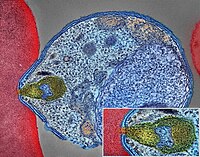
Photo from wikipedia
No specific or adjunctive therapies exist to treat cerebral malaria (CM) as of date. CM is a neuropathological manifestation of the malaria infection in humans, caused by the hemoparasitic pathogen… Click to show full abstract
No specific or adjunctive therapies exist to treat cerebral malaria (CM) as of date. CM is a neuropathological manifestation of the malaria infection in humans, caused by the hemoparasitic pathogen Plasmodium falciparum. Driven through a multitude of virulence factors, varied immune responses, variations in brain swelling with regard to the age of patients, parasite biomass, and parasite-typing, the essential pathogenetic mechanisms underlying clinical CM have remained elusive. However, a recent series of studies based on molecular, immunologic, and advanced neuroradiologic and machine-learning approaches have unraveled new trends and insights to better understand and focus on the key determinants of CM in humans. This could possibly be the beginning of the design of new and effective adjunctive therapies that may not be common or applicable to the entire malarious world, but that could, rather, be specific to the variations in the determinants of CM.
Journal Title: Pathogens
Year Published: 2023
Link to full text (if available)
Share on Social Media: Sign Up to like & get
recommendations!